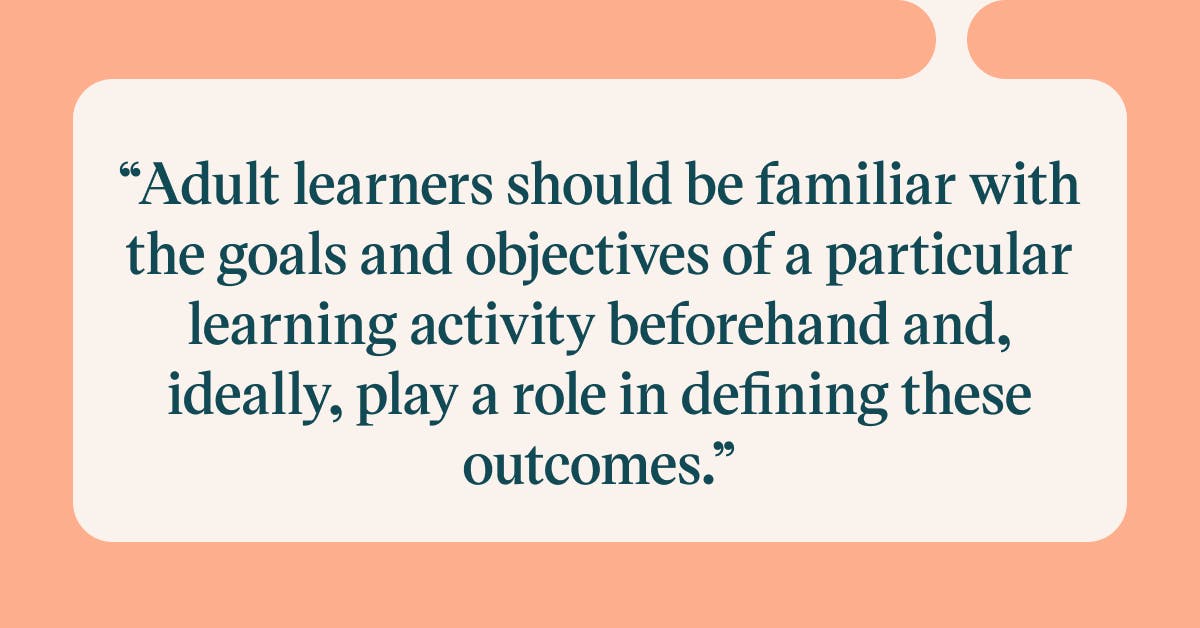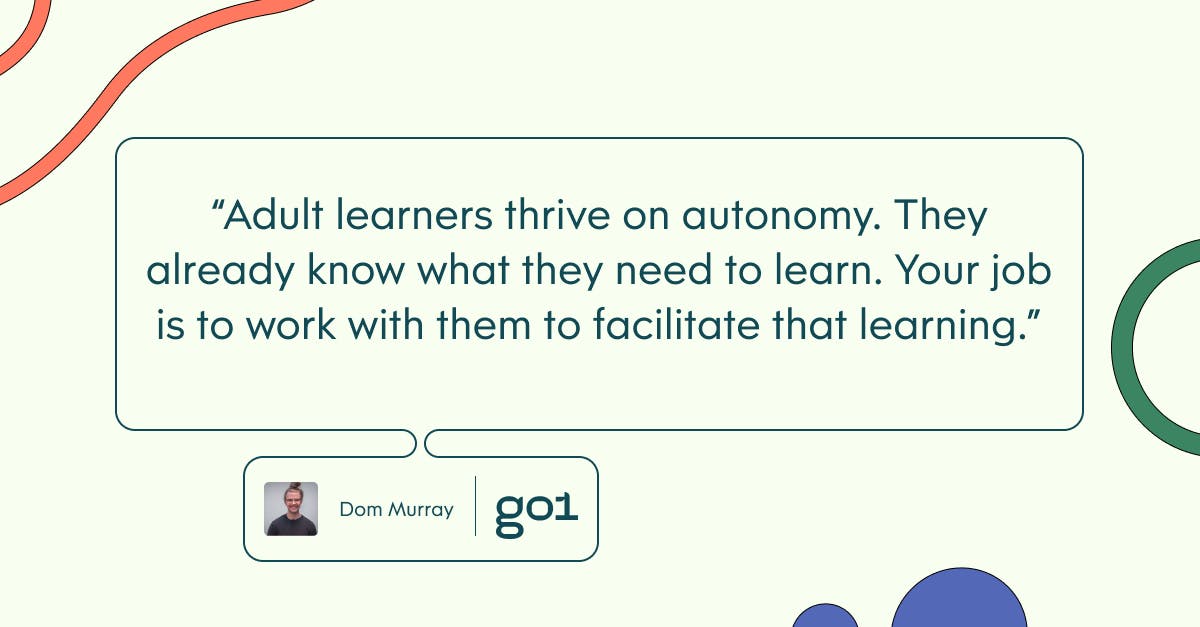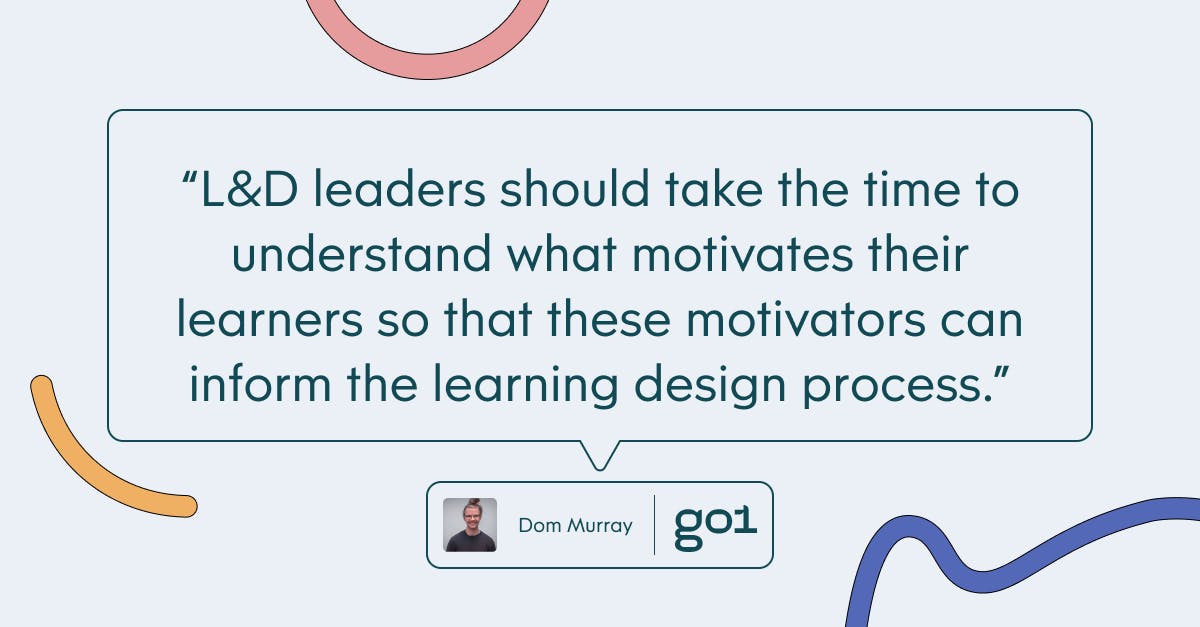
Adult learning principles: what are they and how to apply them

Learning should be a lifelong pursuit. As the saying goes, you learn something new every day. Yet, too often, we think of learning as something that happens at school and other formal institutions when we’re younger.
Without this formal setting, adult learning is often an afterthought; something that just happens, with little thought given to how to best approach and structure this learning.
At Go1, we think this is a shame. After all, a love of learning is one of life’s great gifts. Adult learning principles should be considered and bespoke, differing vastly from childhood learning principles. By approaching the two similarly, we deprive many adults of the opportunity to experience engaging, relevant lifelong learning.

So, we’ve decided to examine the fundamentals of adult learning principles to aid your learning journey. We’ll start by asking what adult learning principles are, before analysing the six principles of adult learning.
What are adult learning principles?
In the mid-1970s, American educator Malcolm Knowles began to recognise that adult learning differs significantly from childhood learning. These differences are due to adults having lived much longer lives, and therefore already have motivations and experiences that drive them. Understanding these differences means learning can be just as effective following adolescence. To describe this theory, Knowles popularised the term andragogy to refer to adult learning.
Andragogy is the opposite of pedagogy, which refers to childhood learning. As such, adult learning theory explores the different ways adults retain new information. By understanding this, it enables teachers and trainers to prepare lessons and materials which benefit a wider range of learners.
The term andragogy is derived from the Greek words andra, meaning 'man', and agogos, meaning 'leader of'. Literally translated, andragogy means ‘leading man’ or ‘man-leading’.
As Enablers of Change explains, “Knowles saw that adults learned differently from children – something that seems obvious now – but he was able to articulate this difference with the concept of andragogy.”
These days, it may seem self-evident that adults and children learn very differently. However, in Knowles’ era, this was a significant breakthrough.
Instructional Design expands on this, adding that Knowles’ conception of andragogy was “an attempt to develop a theory specifically for adult learning. Knowles emphasises that adults are self-directed and expect to take responsibility for decisions. Adult learning programs must accommodate this fundamental aspect…andragogy means that instruction for adults needs to focus more on the process and less on the content being taught.”
Accordingly, Knowles outlined four overarching principles that define adult learning. These are:
- Adults should take ownership of the planning and evaluation of their learning
- Experience (including mistakes) provides the basis of adult learning activities
- Adults are most interested in subjects that have immediate relevance to their job or personal life
- Adult learning should be problem-centred rather than content-centred
As such, autonomy, relevance, and self-directed learning are central pillars of Knowles’ theory of andragogy. Whereas childhood learning typically focuses more on the ‘what’ — such as learning basic facts and skills — adult learning focuses more on the ‘why’, i.e. the processes and reasoning that underpin a specific learning activity.
Put simply, adult learning should strive to answer the question: “what’s in it for me?” Additionally, adult learners should be familiar with the goals and objectives of a particular learning activity beforehand and, ideally, play a role in defining these outcomes. Finally, the content should be relevant to the learners’ life and prior experiences.

As well as Andragogy, there are several other similar adult learning theories, including:
- Transformative learning: this theory aims to “change” the student by first using experiences that relate to the student, then undertaking activities that challenge those experiences and offer other points of view.
- Self-directed learning: this theory understands that learning is a personal journey and students must use their initiative so they can discover their own learning goals, needs, and strategies.
- Experiential learning: this theory is about relating experiences to knowledge. With experiential learning, students learn by doing, including role-playing and using simulations.
To summarise, in Knowles’ own words, “an essential aspect of maturing is developing the ability to take increasing responsibility for our own lives — to become increasingly self-directed.”
Why are adult learning theories so important?
The importance of adult learning theory is simple: without it, educators can't provide an ideal learning environment for their adult students - which, in the case of a business, is everyone. There is no correct approach to adult learning because there are many variations in how adults retain information. However, employing adult learning principles gives students the best chance to develop.
When you adopt adult learning techniques into your business’s training and development strategy, you increase opportunities for upskilling and decrease the risk of unnecessary stress.
In addition to this, there are many more benefits to applying adult learning principles at work, such as:
- Gives students a renewed passion for learning, which increases their engagement.
- When students retain information, they can put what they’ve learned into practice, which increases the ROI of your training and development strategy.
- By learning new skills and knowledge, employees feel confident in their abilities, which builds self-esteem and improves job satisfaction - this can also help reduce staff turnover.
- Adult learners have a wealth of life experience they can use to apply context to what they’re learning.
Applying the six adult learning principles
Now that we understand what adult learning principles — or andragogy — are and why they're important, it’s time to look at these principles in detail.
As part of his work, Knowles outlined six principles of adult learning. Let’s analyse these six adult learning principles, including how to apply them in an L&D setting.
Need to know
First things first, adults must understand why they need to learn something. Without understanding why the learning is relevant, adults will quickly lose interest and disengage.
While children are like sponges, soaking up vast swathes of information, adult learners are far more discerning. They can distinguish between information they need to know and information that is extraneous to their immediate needs.
So, before designing a learning module, ask yourself, 'what are the key objectives and desired outcomes of this activity?' Put yourself in the learner’s shoes and ponder, ‘what’s in it for me?’
If you can't answer these basic questions, then it is likely that the learning activity will not be relevant or engaging for your learners.
Experience
As a child, everything is fresh and exciting. You are learning things for the first time and taking in new experiences. In contrast, adults are experienced learners. From school to informal learning to workplace training and everything in between, they have been there and done that.
According to eLearning Industry, “as a person matures, they accumulate a growing reservoir of experience that becomes an increasing resource for learning.” So, even if an adult learner is unfamiliar with a particular concept or subject matter, they can relate it to other skills and lived experiences to inform the learning process.
This rich wealth of experience should inform learning activities as an adult. Your job as a learning designer is to match this experience with new materials to enrich the learning process. As Maestro Learning explains, “finding ways to integrate this experience with discussion groups and debriefs can be a neat way to help your learners feel like you see the value they bring, too.”
Self-concept
Adult learners thrive on autonomy. They already know what they need to learn. Your job is to work with them to facilitate that learning.

Given this, adult learners should be responsible for driving their learning decisions and outcomes. Offer your learners meaningful choices, and watch them thrive. They should also feel like they have ownership over their learning. They are capable of deciding when, where, how, and even if they need to learn something. Therefore, providing opportunities for self-directed learning is vital.
As Knowles put it: “adults believe they are responsible for their lives. They need to be seen and treated as capable and self-directed.”
For more insights into this step, check out our articles on the benefits of self-directed learning and self-leadership.
Readiness to learn
Adults learn best when the subject matter can help them solve a pressing, real-life problem.
While children absorb information as it is presented to them, adults are far more discerning. Unlike children attending school, adults are rarely forced to learn, meaning they can pick and choose what they would like to learn.
So, when adults do choose to learn something, they are ready. There should be no barriers or obstacles to learning — adults are prepared to learn. Think of it this way: you are up for a big promotion that hinges on learning a new skill. In this situation, you are ready and motivated to learn.
As the University of Phoenix suggested in a recent article, “renewing your readiness to learn as an adult often happens by way of a situational trigger. Perhaps you lose your job or want to switch careers, for example.”
When mapping out a learning activity, put yourself in your learners’ shoes and ask, ‘is this relevant to my needs?’ or ‘how will this help me?’ Above all, design your learning to address an immediate, relevant need.
Problem orientation
As an adult, learning shifts from being subject-oriented to being goal-oriented. Accordingly, adults should understand the desired outcomes of a learning activity beforehand — what problem is this learning activity trying to address?
As Maestro Learning puts it, “adults move away from subject-based learning, which centres around simply knowing about a concept, towards problem-based learning, which focuses on knowledge that tangibly contributes to problem-solving.”
When designing adult learning activities, ensure they solve an explicit, real-life problem.
Intrinsic motivation
Finally, Knowles theorised that, in general, adults are intrinsically motivated to learn rather than extrinsically motivated to learn.
Examples of intrinsic learning motivations include professional development opportunities, interest in a particular subject, increased job satisfaction, improved self-esteem, or a general love of learning.
On the other hand, extrinsic motivations include tangible rewards such as trophies, praise, recognition, or a bonus or promotion.
While extrinsic motivations sometimes apply to adult learners, intrinsic motivators are far more likely to be sustainable in the long term.
As Brilliant Learning Systems notes, “a better way to motivate learners is to find their internal motivator. These intrinsic motivators are things like knowing something makes them feel better about themselves or will give them more opportunities to grow professionally. These types of motivators have more long-term motivational power.”

As a result, L&D leaders should take the time to understand what motivates their learners so that these motivators can inform the learning design process.
For more insights, be sure to subscribe to the Go1 newsletter to stay on top of all the latest L&D trends. Or, you can book a demo today to find out how Go1 can help with your team’s learning needs.




